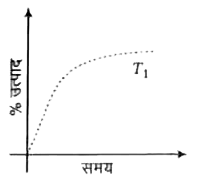For 2NH3(g)Pt−−−−−→Δ products follows zero order kinetics. If t1/2 at p = 4 atm is 25 sec, t1/2 at p = 16 atm will be (in sec)Solution in Telugu
6.25
625
100
(25)14
The correct Answer is:C
Step by step video, text & image solution for For 2NH_3(g) underset(Delta)overset(Pt)(to) products follows zero order kinetics. If t_(1//2) at p = 4 atm is 25 sec, t_(1//2) at p = 16 atm will be (in sec) by Chemistry experts to help you in doubts & scoring excellent marks in Class 12 exams.
Updated on:21/07/2023Topper's Solved these Questions
- REVISION EXERCISE BOOK - AAKASH SERIESCHAPTER - REVISION EXERCISE EXERCISE - ELECTROCHEMISTRY
65 Videos
- REVISION EXERCISE BOOK - AAKASH SERIESCHAPTER - REVISION EXERCISE EXERCISE - SURFACE CHEMISTRY
45 Videos
- REVISION EXERCISE BOOK - AAKASH SERIESCHAPTER - REVISION EXERCISE EXERCISE - SOLID STATE
9 Videos
- REDOX REACTONSBOOK - AAKASH SERIESCHAPTER - REDOX REACTONSEXERCISE - Questions For Descriptive Answers
27 Videos
- SOLID STATEBOOK - AAKASH SERIESCHAPTER - SOLID STATEEXERCISE - PRACTICE SHEET - 5
30 Videos
Similar Questions
Same amount of electric current is passed through solutions of AgNO3 and HCl. If 1.08 g of silver is obtained in the first case, the volume of hydrogen liberated at S.T.P. in the second case is
View SolutionIn an adsorption experiment a graph between log x/m vs. log p is found to be linear with a slope of 45∘ . The intercept on the log x/m axis was found to be 0.3010. What is x/m if pressure is 0.6 bar
View SolutionIn a solid AB having the NaCZ structure. ‘A’ atoms occupy the corners of the cubic unit cell. If all the edge-centred atoms along one of the axes are removed, then the resultant stoichiometry of the solid is
View SolutionHow are no electron transfer reactions different from redox reactions ?
View SolutionThe closest-packing sequence ABAB....... represents
View SolutionThe major product of the following reaction overset((1) t_(Bu) OK)underset((2) Conc. H_(2)SO_(4)//Delta)to
View SolutionIf P is in equilibrium then T_(1)/T_(2) is
View SolutionAn ideal gas was subjected to following process: (n1=2mole,T1=400K,P1=1atm)
Reversible Isobarically−−−−−−−−−−−−→(n2−2mole,T2=300K,P2=1atm)
The work done by the gas is:
View Solutiont_(x//y) = time in which x//y fraction of reactant converts into product. {:(,"Column-I",,"Column-II"),("(a)",t_(5//9),,(p)Equal t o 54 sec if t_(1//3) "is 18 sec in case of first order reaction"),("(b)",t_(19//27),,(q)Equal t o 32 sec if t_(1//14) "is 16 sec in case of first order reaction"),("(c)",t_(7//8),,(r)Equal t o 56 sec if t_(1//3) "is 4 sec in case of second order reaction"),("(d)",t_(7//16),,(t)Equal t o 30 sec if t_(1//3) "is 18 sec incase of zero order reaction"),(,,,(t)Equal t o 28 sec if t_(1//2) "is 16 sec in case of zero order reaction"):}
View SolutionFind the missing parameters.
P=1atmP=1atmP=1atmV1=0.3dm3V2=?V3=0.15dm3T1=200KT2=300KT3=?K
View Solutionअभिक्रिया, N2(g)+3H2(g)↔2NH3(g), ΔH<0 में अमोनिया के प्रतिशतता उत्पाद (% yield) की समय (time) पर निर्भरता (p,T1) पर नीचे दर्शाई गई है
यदि यह अभिक्रिया (p,T2) पर की जाए, जहाँ T2>T1, अमोनिया के % उत्पाद की समय पर निर्भरता प्रदर्शित करता है

View SolutionFor 2NH_(3)(g) overset(Pt)underset(Delta)to Products order kinetics. If t_(1//2) at p = 4 atm is 25 sec, t_(1//2) at p = 16 atm will be (in sec)
View SolutionIf a reaction with t1/2=69.3 sec, has a rate constant 10−2sec−1, the order is
View SolutionIf 'P' is in equilibrium then T_(1)//T_(2) is
View SolutionDecomposition of NH_3 on Pt surface follows zero order kinetics. If the initial pressure is 4 atm, the product of t_(1//2) and k equals to
View Solution
